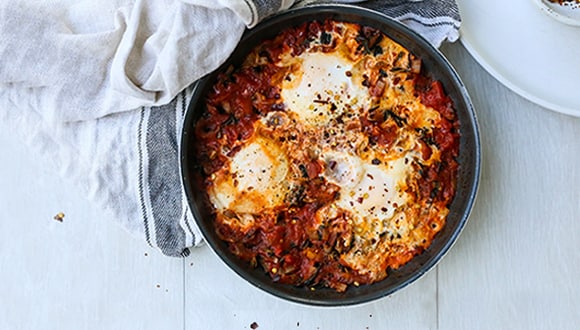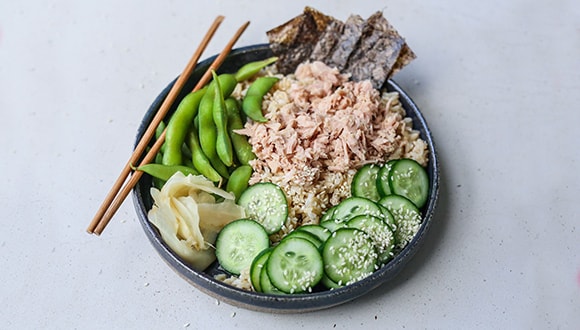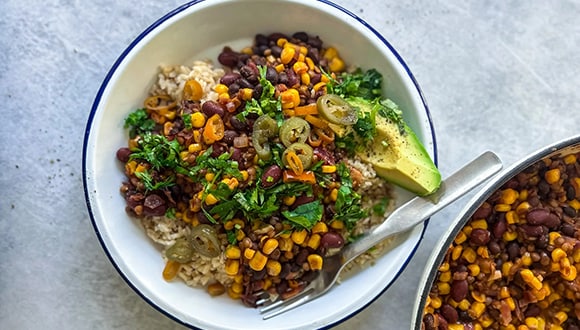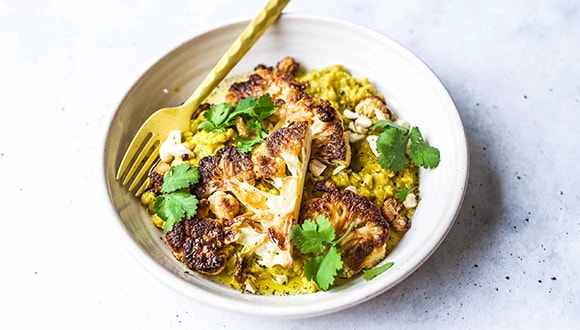4 quick and healthy lunch ideas on a budget
Updated January 2024 | 8 min read
Expert contributors Associate Professor Shelley Wilkinson, principal research fellow in nutrition and dietetics at the University of Queensland; Jacqueline Alwill, nutritionist
Words by Jessica Mudditt
Updated by Donnay Torr
Tired of unhealthy takeaway or the same old sandwich? These cheap and healthy lunch ideas will give you all the nutrients you need to take on the afternoon.
We're often taught from an early age that breakfast is the most important meal of the day, but have we been neglecting the importance of a healthy lunch? Whether you’re sitting down to a well-earned break or quickly grabbing a bite, the midday meal is the perfect opportunity to refuel with the nutrients that will help you power through the rest of your day.
It doesn't need to be expensive or complicated, either. There are plenty of cheap and healthy filling lunch ideas that are quick and easy to prepare and will boost your energy levels and improve your concentration.
"Lunch is the replenishment for the afternoon's activities," says Associate Professor Shelley Wilkinson, a senior principal research fellow in the school of pharmacy at the University of Queensland. "A well-planned lunch gives us energy to tackle what’s ahead and can help prevent that afternoon slump, and maybe the less desirable choices that come with it."
Accredited nutritionist and founder of Brownpaper Nutrition, Jacqueline Alwill, adds that a nutritionally balanced lunch can reduce inflammation, improve focus and help keep blood sugar levels stable. "It also satisfies our appetite, so we aren’t digging into the snack cupboard later," says Jacqueline.
Why a healthy lunch is so important
A balanced diet has many benefits for children and adults of all ages, including maintaining a healthy weight, improving gut health, protecting the heart and staving off diseases such as cancer.
Research consistently suggests that eating a healthy diet can improve children's mental health, support their physical growth, enhance cognitive skills – like concentration and memory – and improve academic performance. A 2020 school lunch trial in Tasmania focused on providing free, nutritious, cooked lunches to students in three schools found that children were able to concentrate better in class before and after lunch, and also reported a reduced number of behavioural issues after lunch.
For older people, a healthy lunch can be essential in providing sustenance for the day and protecting against the development of chronic illness. "The link between adequate nutrition and quality of life in older persons is well established," says Assoc Prof Wilkinson. "As people get older there are physiological changes, which mean that digestion isn’t as good and metabolism slows down. Making good, nutritious choices for lunch will boost wellbeing and can help maintain independence and quality of life." Our protein requirements change as we become older, for example, and a nutritious diet also plays an important role in protecting against cognitive decline.
Making the most of your lunch break
What we eat for lunch is important, and so is how we eat. Carving out distraction-free time to eat mindfully can make you feel fuller and mentally calmer, says Jacqueline – so try to step away from your desk, and focus on your fork.
When we eat too quickly, we're likely to consume more kilojoules than we need. In 2019, a UK study found eating more slowly can make people feel full for longer, which may reduce overeating.
Don’t wait too long before eating lunch either – for a start, being over-hungry will probably result in you eating too quickly. A 2022 review examining the link between meal timing (or ‘chrononutrition’) and weight loss found that consuming the majority of your daily energy intake in the morning and early afternoon can boost weight loss and metabolic health (such as improving cholesterol and fasting glucose levels). In contrast, consuming heavier meals later in the day or evening can lead to reduced insulin sensitivity.
Assoc Prof Wilkinson suggests listening to your hunger cues and eating intuitively. An active morning could mean that a bigger lunch is needed, and vice versa if you’ve hardly moved from your desk – so keep an eye on your portion sizes. "I speak to many women who often don’t consume enough food at lunchtime, thinking lighter is better – but this often means reaching for caffeine and sugary pick-me-ups in the afternoon, which can lead to crashing energy levels," says Jacqueline. The solution? Simply consume a little more (healthy) food at lunch.
Meal planning, she adds, is key to ensuring you’re prepared with a week’s worth of nutritious lunches and not reaching for unhealthy takeaway options. "When you climb a mountain, you do it one step at a time – this applies to cementing healthy habits, too."
Ready to create long-term healthy eating habits for the whole family? We’ve partnered with Ethos Health to bring our members Healthy Families for Life and Healthy Teens for Life, which are resources to support kids, from birth to teens, to develop positive nutritional habits for growth and development and reduce the risk of chronic conditions in their future. Eligibility criteria applies*.
How to plan a healthy lunch for work
Healthy lunches don't have to break the bank or take ages to prepare. "There is a common misconception that 'healthy equals expensive', but that's not true," says Jacqueline. When it comes to avoiding meal prep overwhelm, her motto is 'some better than none'. "I think many people feel daunted by meal prepping or get busy and lose momentum. But even the smallest amount of prep makes a difference," she says.
Healthy lunchbox tips – follow this framework:
- Fill half your lunchbox with low-starch vegetables like leafy greens, carrots, cucumbers, tomatoes and steamed greens.
- Add a palm-sized portion of high-quality protein like grilled or poached chicken, fish, legumes (about 1 cup of lentils, chickpeas, kidney beans), eggs and, less frequently, lean red meat.
- Add a fist-sized portion of starchy, slow-burning carbohydrate sources like brown rice, quinoa, baked sweet potato, and wholegrain or legume pasta.
- Finish with a touch of healthy fats like a drizzle of extra virgin olive oil, a few tablespoons of nuts and seeds, or half an avocado.
What’s for lunch?
Looking for inspiration? Try these four healthy lunch recipes from Health on a Budget by Jacqueline Alwill.

Spinach stove top baked eggs
Serves 1
Ingredients
- 1 tsp (5ml) extra virgin olive oil
- 2 cups (80g) shredded chard leaves (you can also use 2 cups baby spinach leaves or 2 shredded kale leaves (stalks removed) if chard is not available)
- 1 cup BPA-free tinned tomatoes (use BPA-free tinned tomatoes or a tomato passata)
- ½ tsp Cajun spice mix
- 3 free-range eggs
Method
- Heat a small frying pan with a lid on medium heat. Once hot, add extra virgin olive oil to coat.
- Add shredded chard and cook for 3 to 4 minutes, then add tomatoes and Cajun spice mix, and mix.
- Make a small space with a spoon on one side of the pan, crack an egg in, then repeat process with remaining eggs.
- Cover with a lid and cook for 5 to 6 minutes. Turn off heat, remove lid and allow dish to cool slightly before eating.
- Serve as is or teamed with rye sourdough or wholegrain toast.

Budget sushi bowl
Serves 1
Ingredients
- 1 cup cooked brown rice (70g or ⅓ cup raw, cooked by absorption)
- 90g can tuna in spring water, drained
- ½ small (80g) Lebanese cucumber
- 1 cup (92g) edamame beans in shell, cooked
- 1 pack toasted seaweed or 1 sheet nori
- 1 tbsp Japanese pickled ginger (optional)
- To serve: Soy sauce, tamari or wasabi
Method
- Place cooked brown rice in a shallow bowl.
- Top with tuna, cucumber and edamame.
- Arrange nori around the bowl or alternatively chop into pieces so it becomes more of a sprinkle around the bowl.
- Add pickled ginger and condiments such as soy sauce and wasabi and enjoy.

Budget-friendly Mexican smoky beans with rice
Serves 4-6
Ingredients
- 1 cup water
- 400g brown rice
- 2 tbsp extra virgin olive oil
- 1 brown onion, peeled and diced
- 2 cloves garlic
- 3 cups (420g) frozen corn
- 1 x 400g can black beans (rinsed and drained, BPA-free)
- 1 x 400g can lentils (rinsed and drained, BPA-free)
- 1 x 400g can kidney beans (rinsed and drained, BPA-free)
- 1-2tsp Mexican spice blend
- 70g (4 tbsp) tomato paste
- Optional extras: ¼ bunch coriander (leaves and stalks chopped), jalapenos, 1 to 2 avocados.
Method
- Cook rice, cover and set aside.
- Heat large frying pan on medium heat, then add extra virgin olive oil, onion and garlic, and cook (stirring) for 5 to 6 minutes.
- Add corn and all the tinned beans with the spice mix, tomato paste and water, and cook for 15 to 20 minutes, on a simmer, stirring throughout.
- Spoon rice into bowls, top with Mexican bean mix and enjoy.

Roasted cauliflower lentil dhal
Serves 4
Ingredients
Roast cauliflower:
- 1 small head cauliflower, cut into florets
- 3 tbsp extra virgin olive oil
Dhal:
- 2 tbsp coconut oil
- 1 small brown onion, finely chopped
- 3 garlic cloves, chopped
- ½ tsp curry powder
- 1 tsp ground cumin
- ½ tsp fenugreek seeds
- pinch of chilli flakes (optional)
- ½ tsp ground cinnamon
- 1½ tsp ground turmeric
- 400g dried red lentils, well rinsed
- 400ml can organic coconut milk, BPA-free
- pinch of sea salt
- To serve: fresh coriander, rice, cashew nuts
Method
- Heat oven to 180°C and line a large baking tray with greaseproof paper.
- Place cauliflower florets on tray, drizzle with extra virgin olive oil, season with sea salt and black pepper, toss to coat, then place in oven to bake for 45 minutes.
- To make the dhal, heat a large saucepan on stove, add coconut oil, melt, then add onion, garlic and spices, cover and cook for 2 to 3 minutes, remove lid, and cook a further 2 minutes.
- Add rinsed lentils, coconut milk and 2¾ cups of water.
- Bring to a simmer, stirring occasionally for 25 to 30 minutes, or until the lentils are almost tender.
- If the mixture begins to stick, add a little water.
- Season with a pinch of salt.
- Serve topped with roasted cauliflower, cashew nuts and fresh coriander.
Lose weight and keep it off
Are you looking for nutritional support to change your eating habits? Eligible HCF members can access the evidence-based CSIRO Total Wellbeing Diet. Join more than 500,000 Aussies who have lost weight, kept it off and improved their health and wellbeing.
Related Articles
How to eat well for less
Life is expensive but healthy food doesn’t have to be. Forget pricey ingredients and choose seasonal produce and ingredients that can make your meals stretch further.
Foods to boost mental health
Eating well not only keeps your body healthy, but your mind, too. Find out more about nutrition and your brain and five foods that can boost your mental health.
Healthy eating after 50
Did you know that your food and nutritional needs change you age? Check out these tips to help keep your bones strong, heart healthy and weight steady.
Workouts for a healthy heart
When it comes to exercise, consistency is key to keeping your heart healthy, says a leading cardiologist. Check out these workout tips to boost your cardiac health.
IMPORTANT INFORMATION
* Service is available to all HCF members with any HCF health insurance product (excluding Overseas Visitors Health Cover), see hcf.com.au/healthyfamilies
This communication contains information which is copyright to The Hospitals Contribution Fund of Australia Limited (HCF). It should not be copied, disclosed or distributed without the authority of HCF. Except as required by law, HCF does not represent, warrant and/or guarantee that this communication is free from errors, virus, interception or interference. All reasonable efforts have been taken to ensure the accuracy of material contained on this website. It’s not intended that this website be comprehensive or render advice. HCF members should rely on authoritative advice they seek from qualified practitioners in the health and medical fields as the information provided on this website is general information only and may not be suitable to individual circumstances or health needs. Please check with your health professional before making any dietary, medical or other health decisions as a result of reading this website.